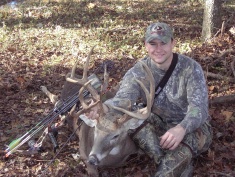
With proper liming, fertilizing, seed planting and weed control, a hunter can produce up to 10,000 pounds of digestible deer forage per food plot acre, per year---at a cost of between $250 to $500 per acre, according to agricultural experts. The average hardwoods acre, however, grows only 50 to 500 pounds of deer forage annually, including choice acorns from oaks.
Thus a well-managed food plot will provide deer, and other game, with 10 to 200 times more forage than wild woods can. You can therefore grow more quality deer food in a one-acre plot than 50 acres of hardwoods can produce. And a food plot does it consistently, year after year, whereas Mother Nature’s hardwoods are fickle.
It’s extremely important to pick a spot for creating a food plot that’s conducive to growing plants. The area should be dry, with no flooding or prolonged moisture. An ideal spot has loamy surface soil with a clay base 15 to 20 inches down. This type soil drains quickly from rain, but unlike sandy soil “holds” good moisture content well below the surface. A potential food plot site should receive direct sunlight through at least 50 percent of the day. Not enough sunlight reaching a food plot is one of the biggest reasons for crop failure on small hunting sites.
In hilly country, food plots should be planted in bottom land, but not in a flood plain. Further, a northeast slope is a good place for a summer food plot because soil moisture doesn't bake out from the sun. Conversely, for a winter plot, a southwest slope is good because that area receives more sun for a longer period, which is helpful in the shorter, cooler growing season.
Once the location, size and configuration of a deer food plot has been determined, the on-site dirty work begins.
First step is to get a soil sample of the site, which is something few hunters want to do, but is without question the surest, quickest, least expensive and painless way to produce a top-quality food plot. The soil sample(s) is next sent to a Soil Conservation Service or an agricultural university for analysis, which costs a few dollars. Tell the people analyzing the soil what type crop you want to plant, like a small grain (wheat, rye or oats) or a legume (clover or alfalfa). If you don’t know what to plant, give the soil analyzers several crop choices, then pick one later.
Soil test results will reveal how much lime the plot requires, and how much and at what ratio elements in the fertilizer are needed for optimum results for the crop planted.
Proper plot preparation is important, with vigorous disking, plowing and tilling to ready the soil. Use only 1/2 the recommended fertilizer and lime during the initial disking. It’s best to put the remaining fertilizer down 30 days later. A plot should be tilled and disked several times, over several weeks, before seeding. And it shouldn't be tilled more than three inches deep, which is easily done with ATV vehicles using special attachments.
Timing the planting when rain is slated for the area is smart to give seedlings a jump-start. Plant seeds during a drought or a deluge, and you can kiss the whole food plot operation good-bye.
Most food plot work is done during the initial stages of establishing plots and carving them out of the woods. Soil samples, disking, seeding, etc. can be tough work, but for thousands of hunters it’s a labor of love---something done in the off-season to bring bucks in your sights during hunting season.
In the Photo: Planting food plots now results in more and better deer in the near future.



























